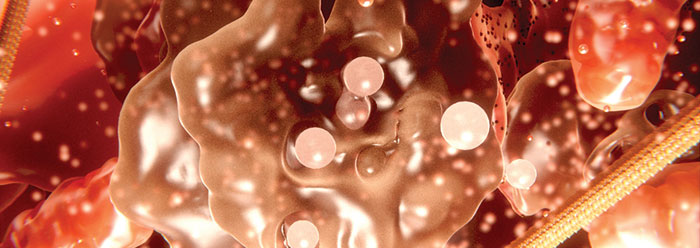One of the biggest problems for evolution is how animal and plant cells, eukaryotes, could have been derived from precursor bacteria-like cells called prokaryotes. Unlike prokaryotes, eukaryotic cells are highly compartmentalized and contain membrane-bound organelles such as the nucleus, mitochondria, and (in plants) chloroplasts that are not found in bacteria or archaea (non-bacterial single-celled prokaryotes). Along with numerous other genetic and molecular differences, these complex cellular organelles not found in prokaryotes, form an unbridgeable gap for evolution to somehow accomplish.1,2
Evolutionists have long struggled to present a non-speculative explanation for the origin of the eukaryotic cell nucleus and other complex cellular features. One idea that has been quite popular for about 50 years is that mitochondria and chloroplasts were derived from a mythical process called endosymbiosis.3 The heart of this explanation is the fact that the mitochondrion possesses a small circular piece of DNA containing some of the genes it needs to function, combined with a process of organelle replication. This functional combination looks similar to how bacterial DNA is constructed and how bacteria reproduce, but the appearances are only superficial.
It is alleged that at some point in the distant past, a prokaryotic cell (perhaps an archaea) engulfed a bacterium (perhaps a proteo-bacterium), and then, invoking a magical jump in lieu of any scientific explanation, hundreds of genes were somehow “retailored” to new purposes. In addition, many thousands of genes were also thought to be transferred into the cell’s nucleus, while others were discarded. The basic idea for this whole scenario was originally boosted by the early discovery of genes in both mitochondrial and eukaryotic nuclear genomes that had regions of similarity to bacterial genes, especially proteo-bacteria.3
However, now that genome sequencing is inexpensive and widespread, the evolutionary story of endosymbiosis has become increasingly clouded and controversial. As new bacterial and eukaryotic genomes are sequenced and the proteins they encode are deduced, the whole evolutionary idea of endosymbiosis has been thrown into utter confusion.
One of the most unexpected discoveries has been the utter lack of identified genes that would support the evolutionary tale. As stated in a recent paper,
What was not anticipated was how relatively few mitochondrial proteins with bacterial homologs [sequence similarity] would group specifically with α-Proteobacteria in phylogenetic [evolutionary tree] reconstructions: At most, only 10–20% of any of the mitochondrial proteomes examined so far display a robust α-proteobacterial signal.4
This lack of evidence for mitochondrial genes derived from bacterial origin in both the mitochondrial DNA and the genome contained in the cell’s nucleus, where most mitochondrial genes are located, is a serious problem for the evolutionary story.
Another major finding contrary to evolutionary endosymbiotic assertions is that there is no display of steady evolutionary progression from simple to complex. Mitochondrial proteomes (the entire set of mitochondrial proteins), even in one-celled eukaryotes such as yeast and protozoa, are already highly complex, diversified, and complete. Also, one-celled eukaryote mitochondrial gene complements are just as complicated as those in plants and animals. A leading evolutionist recently commented, “It has become apparent that the LMCA [last mitochondrial common ancestor] was already as complex in its key functions as modern mitochondria,” and “evidently, basic endosymbiont-to-mitochondrion retailoring was essentially complete before the divergence of the main eukaryotic lineages.”4
The sequences of many eukaryotic genomes are now clearly showing that the gene repertoires needed for the mitochondria to function are not derived from bacteria but are remarkably unique to the type of creature in which they are found. While certain genetic similarities do exist, these correspondences are plausibly explained by the standard engineering concept of code re-use—common code to solve similar problems. The wealth of genomic data is now utterly destroying the idea of evolution on all fronts, even in the area of endosymbiosis, one of the secularists’ favorite theories.
References
- Tan, C. and J. Tomkins. 2015. Information Processing Differences Between Archaea and Eukarya—Implications for Homologs and the Myth of Eukaryogenesis. Answers Research Journal. 8: 121–141.
- Tan, C. and J. Tomkins. 2015. Information Processing Differences Between Bacteria and Eukarya—Implications for the Myth of Eukaryogenesis. Answers Research Journal. 8: 143–162.
- Martin, W. et al. 2001. An overview of endosymbiotic models for the origins of eukaryotes, their ATP-producing organelles (mitochondria and hydrogenosomes), and their heterotrophic lifestyle. Biological Chemisty. 382 (11): 1521–1539.
- Gray, M. W. 2015. Mosaic nature of the mitochondrial proteome: Implications for the origin and evolution of mitochondria. Proceedings of the National Academy of Sciences. 112 (33): 10133–10138.
* Dr. Tomkins is Research Associate at the Institute for Creation Research and received his Ph.D. in genetics from Clemson University.









